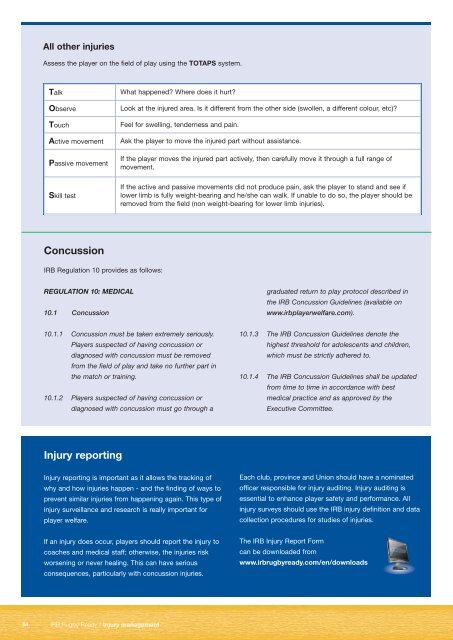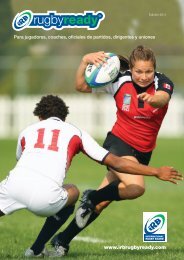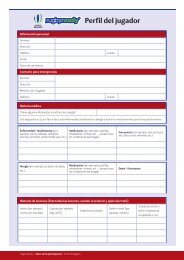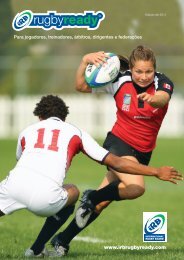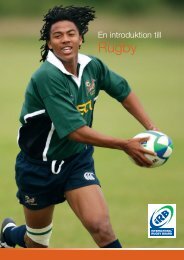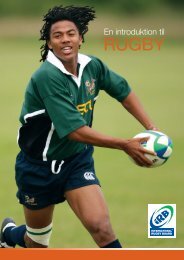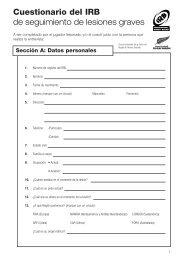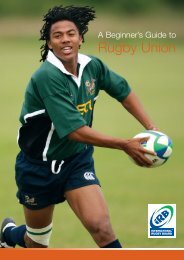IRB Beginner's Guide to Rugby - IRB Rugby Ready
IRB Beginner's Guide to Rugby - IRB Rugby Ready
IRB Beginner's Guide to Rugby - IRB Rugby Ready
Create successful ePaper yourself
Turn your PDF publications into a flip-book with our unique Google optimized e-Paper software.
All other injuries<br />
Assess the player on the field of play using the TOTAPS system.<br />
Talk<br />
Observe<br />
Touch<br />
Active movement<br />
Passive movement<br />
What happened? Where does it hurt?<br />
Look at the injured area. Is it different from the other side (swollen, a different colour, etc)?<br />
Feel for swelling, tenderness and pain.<br />
Ask the player <strong>to</strong> move the injured part without assistance.<br />
If the player moves the injured part actively, then carefully move it through a full range of<br />
movement.<br />
Skill test<br />
If the active and passive movements did not produce pain, ask the player <strong>to</strong> stand and see if<br />
lower limb is fully weight-bearing and he/she can walk. If unable <strong>to</strong> do so, the player should be<br />
removed from the field (non weight-bearing for lower limb injuries).<br />
Concussion<br />
<strong>IRB</strong> Regulation 10 provides as follows:<br />
REGULATION 10: MEDICAL<br />
10.1 Concussion<br />
graduated return <strong>to</strong> play pro<strong>to</strong>col described in<br />
the <strong>IRB</strong> Concussion <strong>Guide</strong>lines (available on<br />
www.irbplayerwelfare.com).<br />
10.1.1 Concussion must be taken extremely seriously.<br />
Players suspected of having concussion or<br />
diagnosed with concussion must be removed<br />
from the field of play and take no further part in<br />
the match or training.<br />
10.1.2 Players suspected of having concussion or<br />
diagnosed with concussion must go through a<br />
10.1.3 The <strong>IRB</strong> Concussion <strong>Guide</strong>lines denote the<br />
highest threshold for adolescents and children,<br />
which must be strictly adhered <strong>to</strong>.<br />
10.1.4 The <strong>IRB</strong> Concussion <strong>Guide</strong>lines shall be updated<br />
from time <strong>to</strong> time in accordance with best<br />
medical practice and as approved by the<br />
Executive Committee.<br />
Injury reporting<br />
Injury reporting is important as it allows the tracking of<br />
why and how injuries happen - and the finding of ways <strong>to</strong><br />
prevent similar injuries from happening again. This type of<br />
injury surveillance and research is really important for<br />
player welfare.<br />
Each club, province and Union should have a nominated<br />
officer responsible for injury auditing. Injury auditing is<br />
essential <strong>to</strong> enhance player safety and performance. All<br />
injury surveys should use the <strong>IRB</strong> injury definition and data<br />
collection procedures for studies of injuries.<br />
If an injury does occur, players should report the injury <strong>to</strong><br />
coaches and medical staff; otherwise, the injuries risk<br />
worsening or never healing. This can have serious<br />
consequences, particularly with concussion injuries.<br />
The <strong>IRB</strong> Injury Report Form<br />
can be downloaded from<br />
www.irbrugbyready.com/en/downloads<br />
54<br />
<strong>IRB</strong> <strong>Rugby</strong> <strong>Ready</strong> / Injury management


